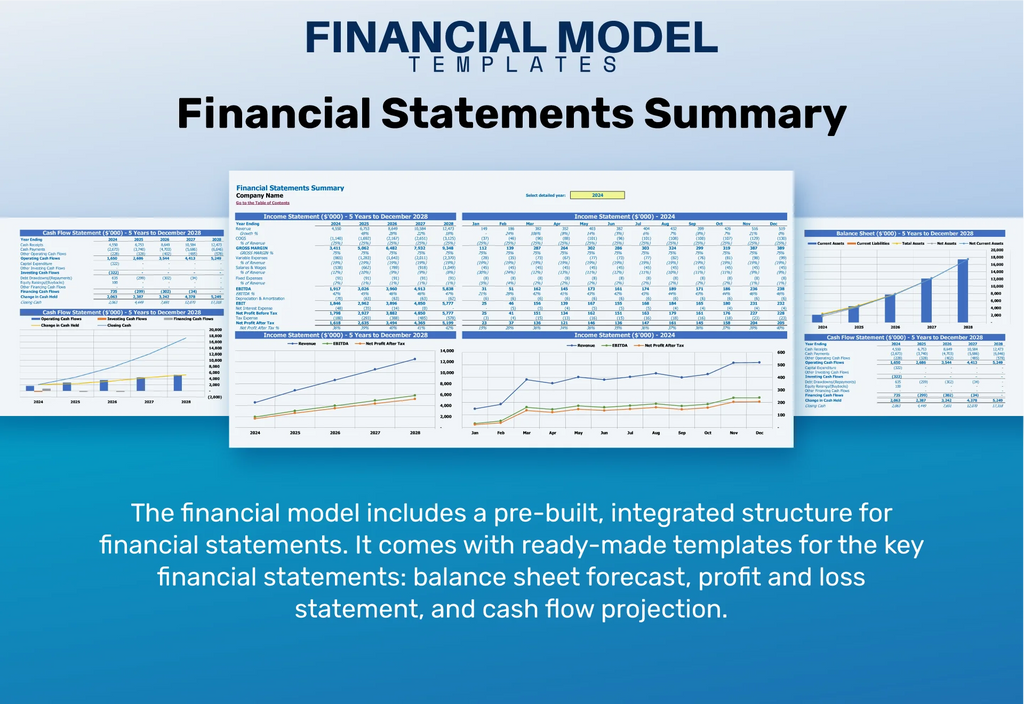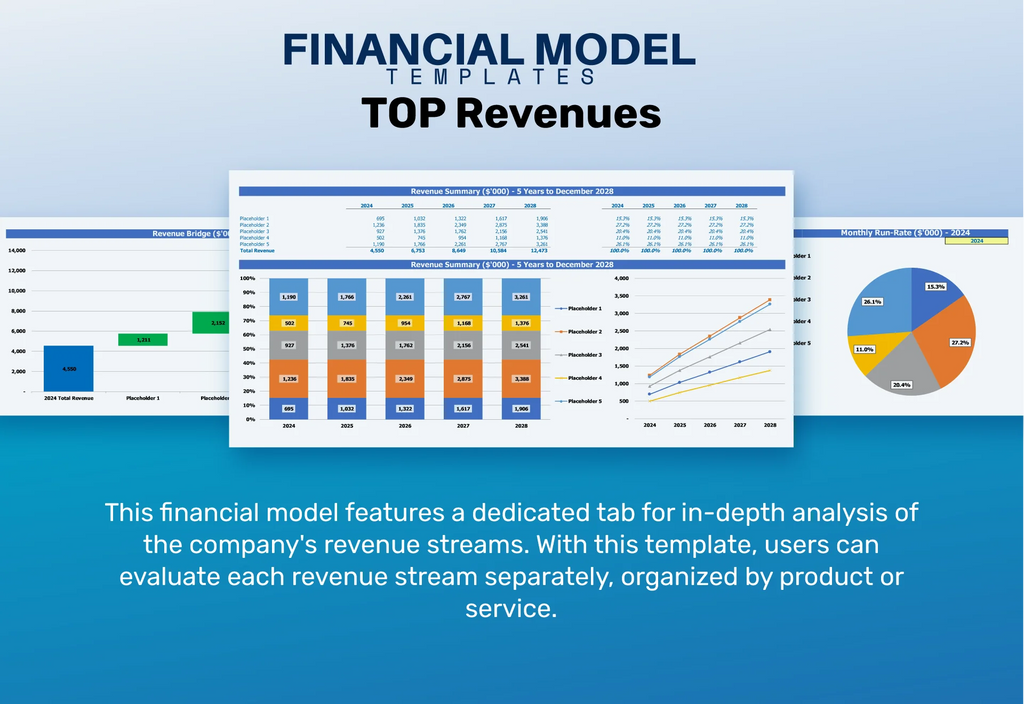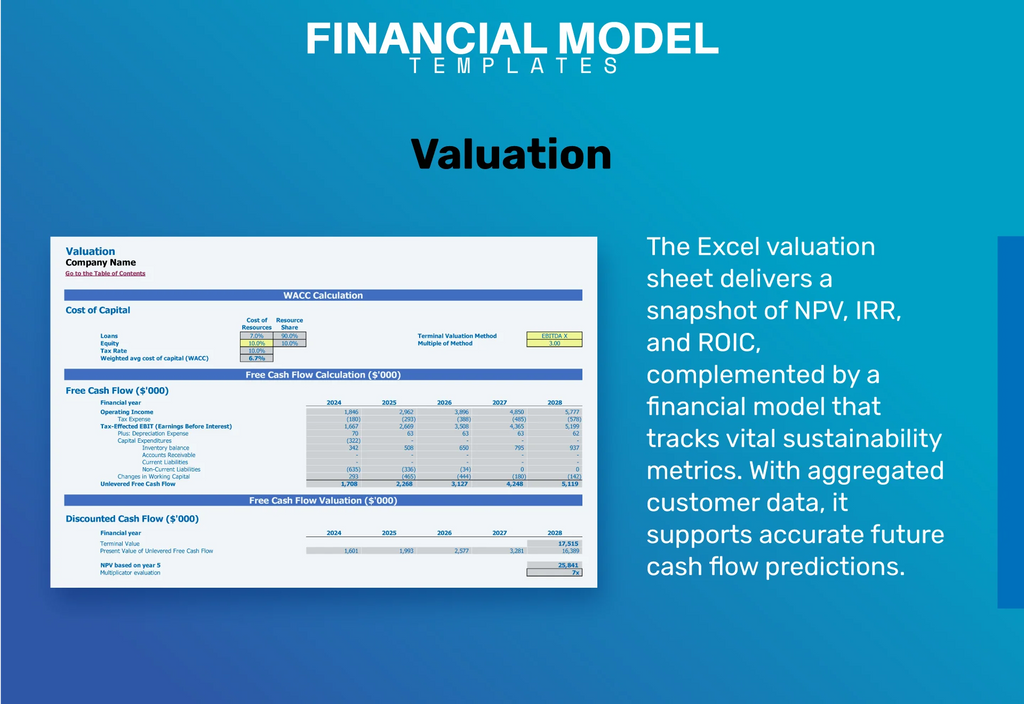Transportation Company Financial Model

- ✔ 5-Year Financial Projections
- ✔ 100% Editable
- ✔ Investor-Approved Valuation Models
- ✔ MAC/PC Compatible, Fully Unlocked
- ✔ No Accounting Or Financial Knowledge
Transportation Company Financial Model
Bundle Includes:
-
Financial Model
-
Business Plan
-
Pitch Deck
-
Financial Dashboard
ALL IN ONE MEGA PACK - CONSIST OF:
transportation company Financial Model/Business Plan Excel Template
Pitch Deck Template For PowerPoint, Keynote & Google Slides
Business Plan Guide and Business Plan Template in MS Word Format
Financial Dashboard in Excel To Track Your Business Performance
TRANSPORTATION COMPANY FINANCIAL MODEL FOR STARTUP INFO
Highlights
This comprehensive transportation business financial planning tool generates a 5-year pro forma Excel template, including profit and loss forecasts, financial statements, and key financial ratios adhering to GAAP or IFRS standards. It focuses on optimizing the logistics company revenue model while providing essential insights into freight transportation financial projections and transportation expense management. Users can leverage operational efficiency metrics, analyze the truck fleet operating costs through a fleet maintenance expense model, and utilize a vehicle depreciation calculator for accurate budgeting techniques. Additionally, the tool supports transportation pricing strategies and market analysis for trucking to enhance delivery service profitability and evaluate transportation capital investment strategies effectively. With features for fuel cost forecasting and reverse logistics revenue streams, this template is invaluable for achieving robust transportation asset management and assessing transportation risk for sustained growth.
The transportation business financial planning template addresses key pain points by streamlining logistics company revenue model assessments and offering reliable freight transportation financial projections. It effectively manages truck fleet operating costs and transportation expense management through detailed insights, fostering improved operational efficiency metrics. The included vehicle depreciation calculator aids in precise budgeting and enhances transportation pricing strategies, while the comprehensive cargo shipping cost structure simplifies expense forecasting. Users benefit from transportation budgeting techniques that incorporate reverse logistics revenue streams and fuel cost forecasting, ultimately providing a holistic view of delivery service profitability analysis. Additionally, the financial model emphasizes transportation asset management and contract negotiation financial impacts, while also including tools for transportation risk assessment and market analysis for trucking, ensuring that all aspects of fleet maintenance and capital investment strategies are systematically addressed.
Description
Our transportation business financial planning model is meticulously crafted to assist you in making strategic business decisions based on precise financial reporting. This logistics company revenue model incorporates essential components, including a five-year freight transportation financial projection, detailed analysis of truck fleet operating costs, and comprehensive transportation expense management strategies. You'll find a vehicle depreciation calculator, operational efficiency metrics, and transportation pricing strategies, all designed to evaluate your cargo shipping cost structure and enhance delivery service profitability analysis. The model further supports transportation budgeting techniques and reverse logistics revenue streams, while providing insights into fuel cost forecasting and transportation capital investment strategies. With a focus on transportation asset management and contract negotiation financial impact, this financial tool also enables a thorough transportation risk assessment and market analysis for trucking, ensuring your fleet maintenance expense model is optimized for long-term success.
TRANSPORTATION COMPANY FINANCIAL MODEL REPORTS
All in One Place
Investors demand robust financial planning from transportation startups. Our comprehensive financial projection model is essential for demonstrating the potential of your logistics company. This five-year forecast template not only aids in validating your capital requirements but also outlines anticipated returns on investment. By incorporating key elements like transportation expense management, vehicle depreciation, and operational efficiency metrics, you can ensure a compelling business case. Strategic insights into pricing strategies and market analysis will further guide your decision-making. Position your freight transportation venture for success with our detailed financial planning tools, essential for attracting investment and driving profitability.

Dashboard
Our startup financial model features an intuitive dashboard that centralizes key indicators for your transportation business. This tool enhances financial planning by incorporating pre-built calculations for streamlined logistics company revenue model evaluations. Easily track transportation expenses, forecast cash flow, and assess operational efficiency metrics. The dashboard empowers you to monitor critical KPIs, ensuring you make informed decisions that drive profitability. Leverage this resource for effective transportation budgeting techniques and to optimize your overall financial performance in the competitive freight transportation sector.

Business Financial Statements
Our comprehensive financial model template in Excel is designed specifically for the transportation business, featuring fully integrated pro forma financial statements. This includes a projected income statement, pro forma balance sheet, and cash flow statement, all presented on a monthly and annual basis. Users can seamlessly incorporate existing financial data from QuickBooks, Xero, FreshBooks, and other accounting software, enabling accurate freight transportation financial projections and rolling forecasts. Enhance your logistics company's revenue model and streamline transportation expense management with our robust forecasting tools. Optimize operational efficiency and drive profitability in your transportation business today.

Sources And Uses Statement
Our financial model template simplifies transportation business financial planning by clearly outlining the source and use of funds. This statement helps stakeholders, including lenders, understand the company's financing needs and strategies. It also showcases alternative funding options, such as crowdfunding, to reassure investors of flexibility during unforeseen circumstances. Moreover, it's crucial that the total from the 'Uses' section balances with the 'Sources' section, ensuring transparency and credibility. Effective budgeting techniques and thorough financial analysis will ultimately enhance operational efficiency metrics, paving the way for sustainable growth in the logistics sector.

Break Even Point In Sales Dollars
This five-year financial projection includes a break-even point analysis, essential for transportation businesses. Identifying when revenue surpasses total costs is critical, marking the start of profitability. Such insights are invaluable for potential investors and creditors as they assess risks and returns of joining the venture. A thorough understanding of the interplay between revenue, fixed, and variable costs enhances operational efficiency metrics, paving the way for effective transportation budgeting techniques and strategic decision-making in logistics company revenue models. This financial foresight lays a robust foundation for sustained growth and informed investment in the transportation sector.

Top Revenue
This financial plan template includes a specialized tab for an in-depth analysis of the company's diverse income streams. Users can leverage this tool to evaluate the revenue model for each product or service individually, enhancing transportation expense management and operational efficiency metrics. By applying this template, logistics companies can refine their transportation pricing strategies, project freight transportation financial outcomes, and assess the impact of contract negotiations. This comprehensive approach supports sound decision-making and strategic planning, ultimately driving profitability in the competitive transport landscape.

Business Top Expenses Spreadsheet
To ensure sustainable profitability in the transportation business, it's essential to analyze and optimize major expenses. Our five-year forecast template includes a comprehensive spending report that highlights the four largest expense categories while categorizing remaining costs as 'other.' This streamlined approach enables effective transportation expense management, allowing businesses to track trends in expenditure variations year over year. For both startups and established companies, diligent financial planning is crucial to maintaining operating efficiency and ensuring long-term success. Utilize this tool to enhance your financial projections and refine your budget strategies effectively.

TRANSPORTATION COMPANY FINANCIAL PROJECTION EXPENSES
Costs
The transportation financial projection model is a vital tool for assessing business viability by analyzing total costs and profit potential. This methodology enhances transportation expense management, allowing logistics companies to identify inefficiencies and develop effective solutions. By employing operational efficiency metrics and advanced budgeting techniques, businesses can optimize their revenue model while ensuring robust capital investment strategies. Ultimately, this model streamlines decision-making, facilitating sound contract negotiations and enhancing overall delivery service profitability.

CAPEX Spending
Capital expenditure (CAPEX) for a transportation startup encompasses significant investments in assets essential for operational success. These expenditures, which influence both the pro forma balance sheet and cash flow statement, are critical for enhancing operational efficiency and technology quality. Properly managing CAPEX ensures effective transportation expense management, fostering growth in logistics company revenue models. By streamlining fleet maintenance and optimizing asset management, the startup can project profitability and develop robust transportation pricing strategies. Ultimately, strategic CAPEX planning contributes to sustained competitive advantage in the freight transportation sector.

Loan Financing Calculator
Our financial model template for startups includes a comprehensive loan amortization plan that calculates both the principal and interest. This tool enables precise forecasting of your transportation business's financial health, considering critical factors such as principal amount, interest rates, loan terms, and payment frequency. Utilize this robust resource for effective transportation expense management, ensuring your logistics company can optimize revenue and enhance operational efficiency metrics. With our template, gain insights into your cargo shipping cost structure and develop sound transportation budgeting techniques to drive profitability and sustainable growth.

TRANSPORTATION COMPANY EXCEL FINANCIAL MODEL METRICS
Financial KPIs
Our financial modeling Excel template empowers transportation businesses with critical KPIs, including earnings and net income growth. As you embark on your logistics journey, the proforma income statement serves as an invaluable tool to monitor expansion and ensure sustainable profit margins. By utilizing our meticulously crafted template, you can seamlessly track sales, revenue growth, and specific profitability metrics. This enhances your understanding of operational efficiency and informs strategic decisions in transportation pricing and expense management, positioning your logistics company for long-term success.

Cash Flow Forecast Excel
A well-crafted startup cash flow projection in Excel is crucial for any transportation business, as it determines your ability to meet essential financial obligations, such as employee salaries and operational expenses. This financial planning tool not only aids in assessing your truck fleet operating costs but also supports transportation expense management and informs transportation pricing strategies. Leveraging this analysis ensures long-term delivery service profitability and operational efficiency, paving the way for effective contract negotiation and sustainable growth within the logistics sector.

KPI Benchmarks
Benchmarking is essential for creating an objective pro forma income statement in the transportation business. By comparing key metrics—such as operating costs, profit margins, and productivity—against industry leaders, companies can gain invaluable insights into their financial health. This process aids in transportation expense management and identifies areas for improvement. For startups, leveraging operational efficiency metrics can reveal critical opportunities for growth and enhance delivery service profitability. Ultimately, effective benchmarking fosters strategic financial planning and informed transportation capital investment strategies, driving long-term success in a competitive logistics landscape.

P&L Statement Excel
The income statement is a critical component of your proforma business plan, showcasing the bottom line and overall profitability of your transportation business. A well-crafted profit and loss (P&L) statement is essential for effective financial planning and expense management. Without precise financial projections and documented revenues, even a thriving logistics company risks making uninformed decisions. Accurate numbers provide clarity, enabling better assessment of operational efficiency, budgeting techniques, and asset management. Ensure your P&L reflects all facets of your operations—from truck fleet operating costs to transportation pricing strategies—to drive success and safeguard against potential risks.

Pro Forma Balance Sheet Template Excel
The projected balance sheet is crucial for feasibility studies, particularly within the transportation business. Integrated with the P&L statement and cash flow forecasts, it allows investors to assess the viability of net income projections. While the cash flow statement often captures more attention, the pro forma balance sheet provides insights into transportation asset management, supporting effective operational efficiency metrics. Additionally, it enables potential investors to evaluate returns, such as return on equity (ROE) and return on capital (ROC), ensuring informed decisions regarding capital investment strategies in logistics and freight transportation.

TRANSPORTATION COMPANY FINANCIAL PROJECTION TEMPLATE VALUATION
Startup Valuation Model
Our comprehensive startup valuation model for the transportation business features a robust three-statement Excel template, catering to essential investor inquiries. By incorporating insights from transportation financial planning, we present a weighted average cost of capital (WACC) that assures stakeholders of a minimum return on investment. Our Free Cash Flow Valuation reveals the cash available to investors, while the Discounted Cash Flow analysis evaluates the present value of future cash flows, enhancing transparency and confidence in your logistics company's revenue model and operational efficiency metrics.

Cap Table
The Pro Forma Cap Table delivers comprehensive insights into a company's financial landscape, detailing ownership structures and investor stakes. It encompasses equity and preferred shares, options, and other key indicators, providing a clear picture of the organization’s financial health. This invaluable tool aids in transportation business financial planning, facilitating informed decision-making regarding capital investments, contract negotiations, and operational efficiency metrics. By analyzing these elements, stakeholders can optimize transportation expense management and enhance profitability within the logistics sector.

KEY FEATURES
Implementing a robust financial model enables transportation businesses to identify cash gaps and surpluses proactively, enhancing financial stability.
Effective financial projections empower transportation businesses to anticipate cash flow needs and seize growth opportunities proactively.
Implementing a robust financial model enhances transportation expense management, ensuring optimized revenue and improved operational efficiency across logistics.
Our financial model streamlines transportation budgeting techniques, ensuring precise projections and compliance with lender requirements for optimal profitability.
Implementing effective transportation financial models enhances operational efficiency, drives profitability, and supports strategic growth in the logistics sector.
Utilizing financial projections empowers transportation companies to effectively plan for growth, optimize expenses, and enhance profitability through strategic decision-making.
Effective financial planning enhances operational efficiency metrics, enabling logistics companies to optimize revenue models and reduce transportation costs.
Optimize your transportation business with a robust 5-year financial model, enhancing forecasting accuracy and driving strategic decision-making.
Effective transportation financial planning enhances operational efficiency, optimizing costs and maximizing profitability for logistics companies.
Streamline your transportation business growth with an easy-to-use financial model, eliminating complexity and empowering informed decision-making.
ADVANTAGES
Optimize your transportation business with a financial model that enhances budgeting techniques and boosts delivery service profitability.
Implementing a comprehensive financial model enhances operational efficiency and profitability in your transportation business.
A robust financial model enhances transportation expense management, improving cash flow and preventing overdue payments for logistics companies.
A robust transportation financial model enhances profitability by optimizing asset management and informing strategic pricing decisions for logistics companies.
A robust financial model enhances transportation business profitability by optimizing expense management and improving revenue forecasting and operational efficiency.




